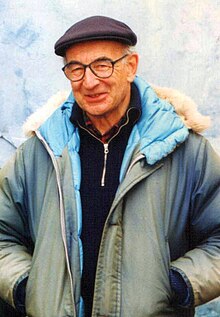Hansjürgen Müller-Beck

Hansjürgen Müller-Beck (born August 13, 1927 in Apolda ; † August 2, 2018 in Bern ) was a German prehistorian .
Life
Hansjürgen Müller-Beck attended school in Berlin and had to break off his Abitur at the humanistic Mommsen-Gymnasium in April 1944 in order to do military service in the Second World War by May 1945 . After the end of the war he continued school in Gießen and passed his Abitur in 1949.
From 1950 he studied first sociology, later prehistory and early history, ethnology and geology in Heidelberg with Ernst Wahle . He continued his studies in Bern , Friborg (Switzerland) and Tübingen , where he in 1955 with the work the upper Lower Palaeolithic in southern Germany with Gustav Riek received his doctorate. From 1956 to 1959 he was assistant to Hans-Georg Bandi in the Department of Prehistory and Protohistory of the Bern Historical Museum . In the summer of 1959 he went on a study trip to Anatolia , before joining the German Bolivia expedition as an archaeologist in 1960 under the direction of Hermann Trimborn . Since mid-1962 he has been working as a research assistant at the Prehistoric State Collection in Munich , leading the excavation at Speckberg near Meilenhofen .
After his habilitation in 1965 in Freiburg im Breisgau on "The Leaf Tip Palaeolithic of Northern Europe and North America", he was first visiting professor at the University of Wisconsin and then from 1966 lecturer in Freiburg.
From 1969 until his retirement in 1995, Müller-Beck held a chair at the Institute for Prehistory and the Institute for Hunting Archeology, which was part of the Geoscientific Faculty of the University of Tübingen . Under the direction of Müller-Beck, it had a special position within the archaeological institutes in Germany, since the focus was on scientific and interdisciplinary orientation and only here the doctorate in a prehistoric topic for Dr. rer. nat. the natural sciences was possible. It was not until 1992 that it was merged as the “Department of Prehistory and Hunting Archeology” with the “Department for Younger Prehistory and Archeology of the Middle Ages” to form the Institute for Prehistory and Early History.
From 1970 to 1974 Müller-Beck was chairman of the German Society for Pre- and Protohistory . From 1980 to 1995 he was the secretary of the Commission for the Palecology of Early Man at INQUA and from 1986 to 1989 he was President of the Alfred Wegener Foundation . He was a founding member of the Society for Prehistory and the Association for the Promotion of the Prehistoric Museum Blaubeuren and its chairman from 1997 to 2004.
Research priorities
At the beginning of the 1960s, Müller-Beck was researching Neolithic equipment from excavations at Burgäschisee , which he carried out together with Hans-Georg Bandi . He later carried out a large number of excavations in Europe, Asia and America. The Middle Paleolithic of Europe remained a research focus, while others were arctic archeology as well as ethno-archaeological studies of hunting peoples. Between 1970 and 1975 and 1987 and 1989 he investigated the historic Umingmak musk ox hunting ground on Banks Island in the Canadian Arctic, as well as the way of life of the modern Inuit . A site of the ancient Bering Sea culture on the bank of the Bering Strait (Ekven settlement and burial ground) led him to Chukotka (Siberia) several times from 1995 . He had previously organized exhibitions on this site in Germany and Switzerland. Also in the 1990s he carried out an excavation for the prehistoric settlement of the Sakai Cave ( Trang Province , southern Thailand), combined with documentation of Mani living near the excavation site . His most recent excavations dealt with a prehistoric find region in Seboruco and in the Abri "El Charcón" near Sagua La Grande in Cuba .
literature
- Traces of the hunt - The hunt for traces. Festschrift in honor of Hansjürgen Müller-Beck. 1996, ISBN 3-98048341X .
- Obituary Prof. Dr. Hansjürgen Müller-Beck by Claus-Joachim Kind in: Preservation of monuments in Baden-Württemberg. Newsletter of the State Monument Preservation Volume 47, Issue 4 | 2018, pages 279-280 Personalia .
Fonts
- The upper Old Paleolithic in southern Germany. T. 1: text. Habelt in commission, Bonn 1957.
- with Rudolf Grahmann: Prehistory of Mankind. Kohlhammer, Stuttgart 1967.
- with Joachim Hahn , Wolfgang Taute : Ice Age Caves in the Lone Valley. Archeology of a landscape in the Swabian Alb. Guide to prehistoric and early historical monuments in Württemberg and Hohenzollern. Müller and Gräff, Stuttgart 1973.
- (Ed.) 1983: Prehistory in Baden-Württemberg. Stuttgart, Konrad Theiss Verlag.
- The Stone Age. The way people made history. CH Beck, Munich 1998, ISBN 3-406477194 ( CH Beck Wissen , Volume 91) (4th edition 2008).
- The ice ages. Natural history and human history. CH Beck, Munich 2005, ISBN 3-406508634 (2nd edition 2009).
Web links
- Literature by and about Hansjürgen Müller-Beck in the catalog of the German National Library
- Works by and about Hansjürgen Müller-Beck in the German Digital Library
- Newsletter Uni Tübingen currently No. 3/2018 People: Prehistory and world history. On the death of Professor Dr. Hansjürgen Müller-Beck , an obituary by Miriam Haidle and Berrin Çep
Individual evidence
- ↑ A lord of the world. In: Schwäbisches Tagblatt , August 6, 2018. Retrieved August 6, 2018 (restricted access).
- ↑ Hansjürgen Müller-Beck, Joachim Hahn : The Speckberg near Meilenhofen. Archeology of the Upper Paleolithic. Paperback, 1982, ISBN 978-3784751207 .
- ↑ Leskov, AM and Müller-Beck, H. (Eds.) 1993: Arctic whale hunters 3000 years ago. Unknown Siberian art. Mainz (Hase and Koehler)
| personal data | |
|---|---|
| SURNAME | Müller-Beck, Hansjürgen |
| BRIEF DESCRIPTION | German prehistorian |
| DATE OF BIRTH | August 13, 1927 |
| PLACE OF BIRTH | Apolda |
| DATE OF DEATH | 2nd August 2018 |
| Place of death | Bern |